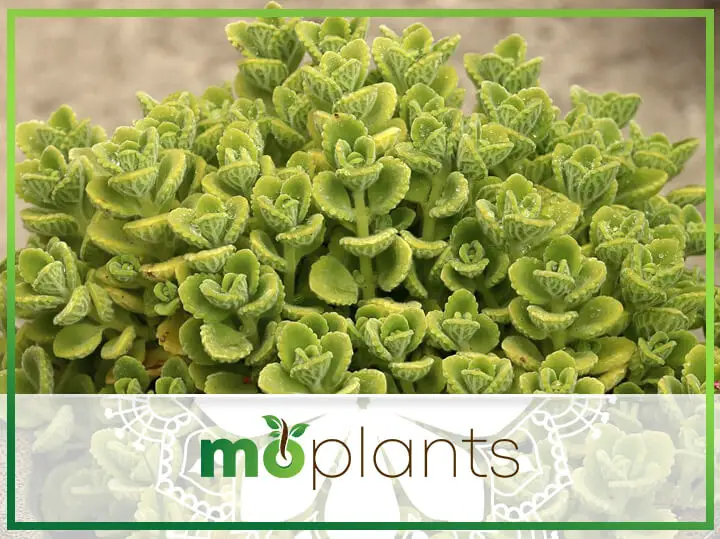Did you think it was an oregano, too? We thought the same at first.
And no – it’s not from Cuba either. So where does the name “Cuban Oregano” come from?
That’s what you’ll find out in this article! And of course, if you’re interested in growing one, we’ll tell you how to as well!
Let’s begin.
What is Cuban Oregano? (Plectranthus Amboinicus)
To help you understand more about Cuban oregano, let’s define what is not first.
Cuban oregano is not:
- Oregano
- Thyme
- Mint
If it’s not any of these things, then what is it then?
The best way to define what Cuban oregano is: a perennial succulent plant known to grow in tropical regions and is commonly found in the coastal regions surrounding the Indian ocean.
Its nicknames include:
- Mexican mint
- Spanish thyme
- Indian borage
- Caribbean oregano
- Hung chanh
- Broadleaf thyme
- French thyme
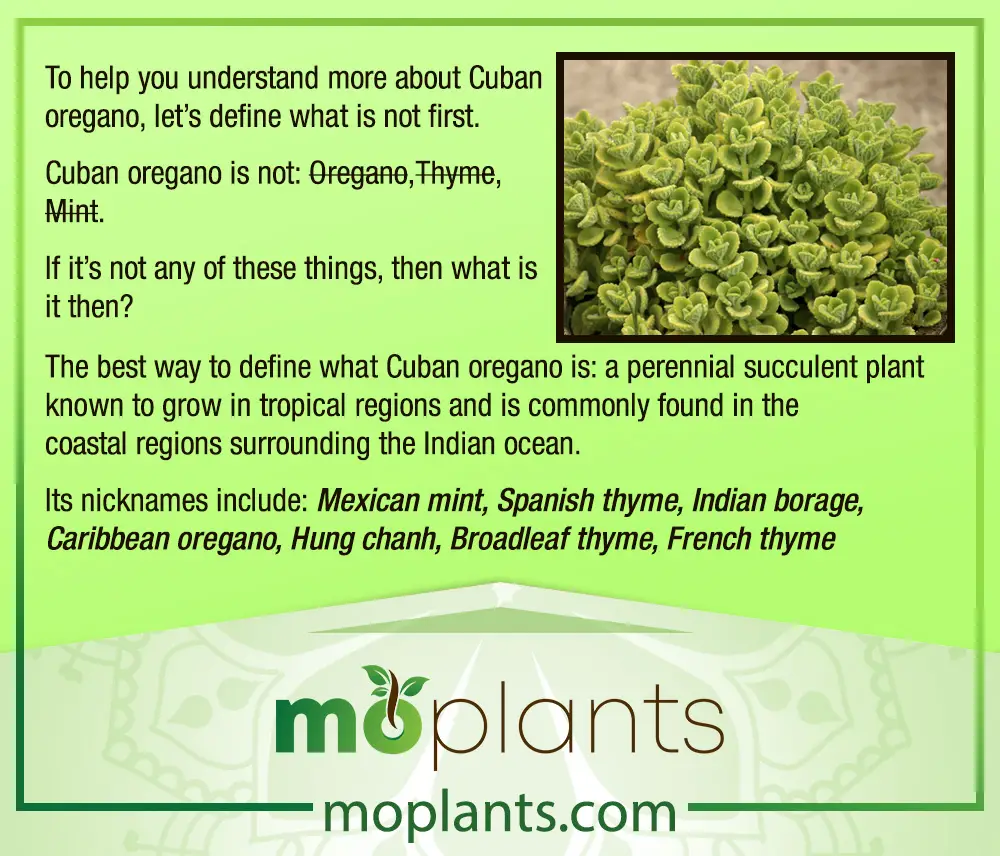
Contrary to its name, Cuban oregano (plectranthus amboinicus) does not originate from Cuba, but it rather added to “jerk” seasoning blends, salsas, and bean dishes for local cuisines in Cuba, Philippines, and India.
However, its smell closely resembles that of true oregano, giving off a strong menthol or camphor scent. Some might say it also smells similar to thyme or rosemary with a touch of lemon.
This doesn’t come as a surprise since it is a member of the mint family. Some even refer to it as a Vicks plant due to its strong menthol aroma.

Now, what about its leaves?
Cuban oregano leaves are characterized as fuzzy or velvety and fragrant. Its leaves are also grayish-green and finely haired with saw-toothed edges.
You’ll also notice the leaves edged in trumpet-shaped flowers and when in bloom, can produce colors in pink, lavender, or white.
As for its growing conditions, Cuban oregano doesn’t fare well in regions with full sun. Since it favors tropical areas over cold climates, it’s ideal to grow Cuban oregano in a garden container.
Furthermore, Cuban oregano can grow between 12 to 18 inches while typically leaving a trailing habit. This gives it an appealing, lush display when grown in a hanging basket.
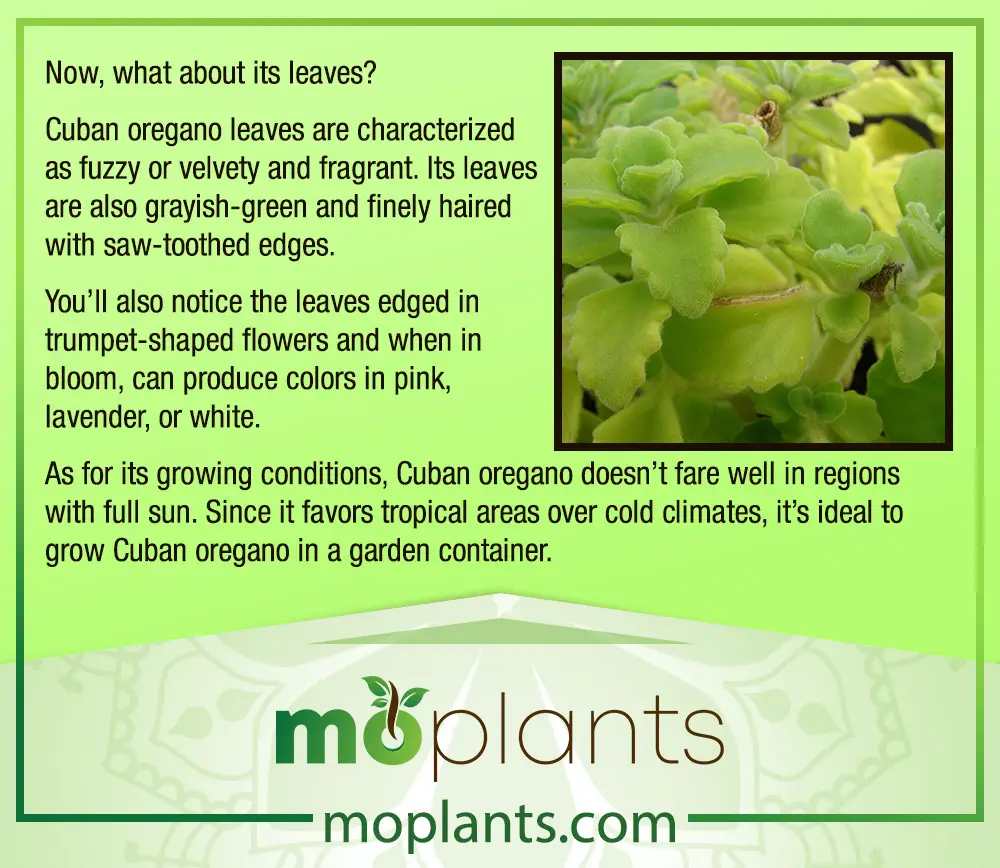
Infographic

Benefits & Uses of Cuban Oregano
Given its various nicknames as a Mexican mint, Indian borage, Spanish thyme, Hung chanh, and even as Caribbean oregano, Cuban oregano has a wide array of uses and benefits dating back to Ayurvedic practices in India and Indonesia.
Cuban oregano leaves have been used for centuries to treat throat and respiratory infections, including constipation, rheumatism, flatulence, and relieve fever.
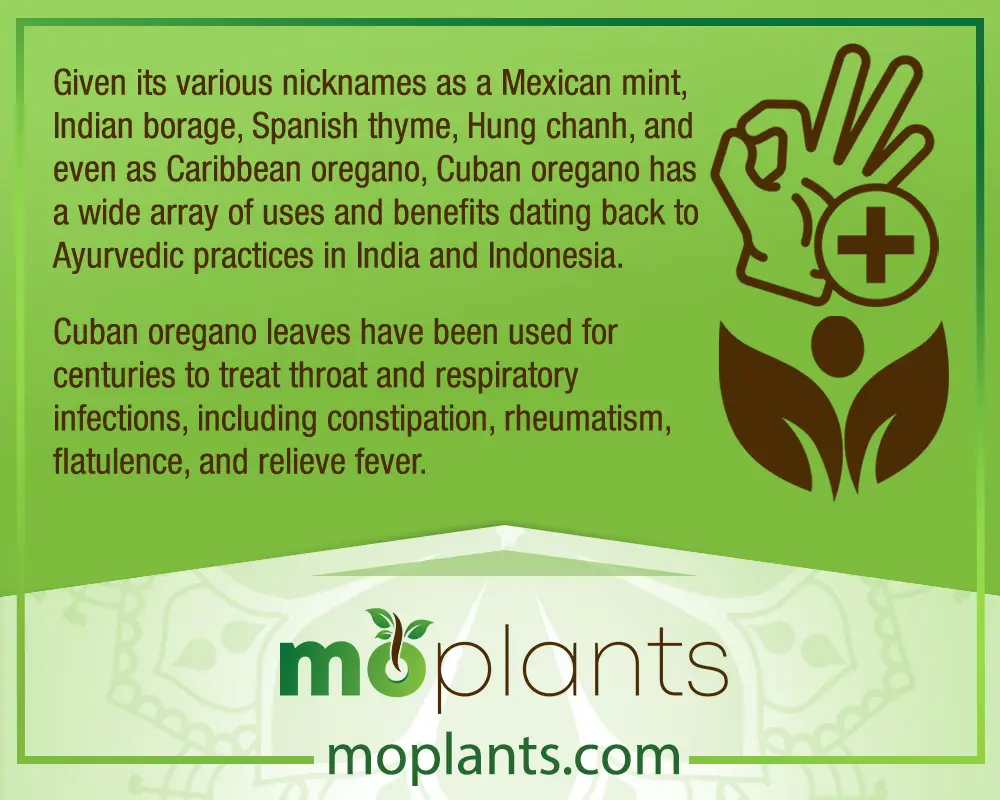
Due to its strong scent, its culinary prowess is just as useful.
For stuffing, poultry, beef, lamb, and a variety of meat dishes, Cuban oregano is used as a substitute for Mediterranean oreganos either dried or fresh.
Its fresh leaves also pack a strong flavor, making it a great addition for soups and stews.
Be cautious, though! Due to its strong flavor, adding the leaves to game dishes can overpower the dishes. Surprisingly, it’s even used as a flavoring in some beers and wines. How amazing is that!

Now, this isn’t all that plectranthus amboinicus has to offer.
This frost-tender herb was known to serve as an essential plant for rituals, cleansing magic, offerings, and to consecrate a place of worship. Cuban oregano signified that fairies blessed a certain place.
For a more organic approach, rubbing the leaves on your skin serves as a repellant against mosquitoes and insect bites.
If you’re looking for a natural insect repellant without any synthetic chemicals, you have yourself a safe plant you can use to ward off those pesky bugs. [R]
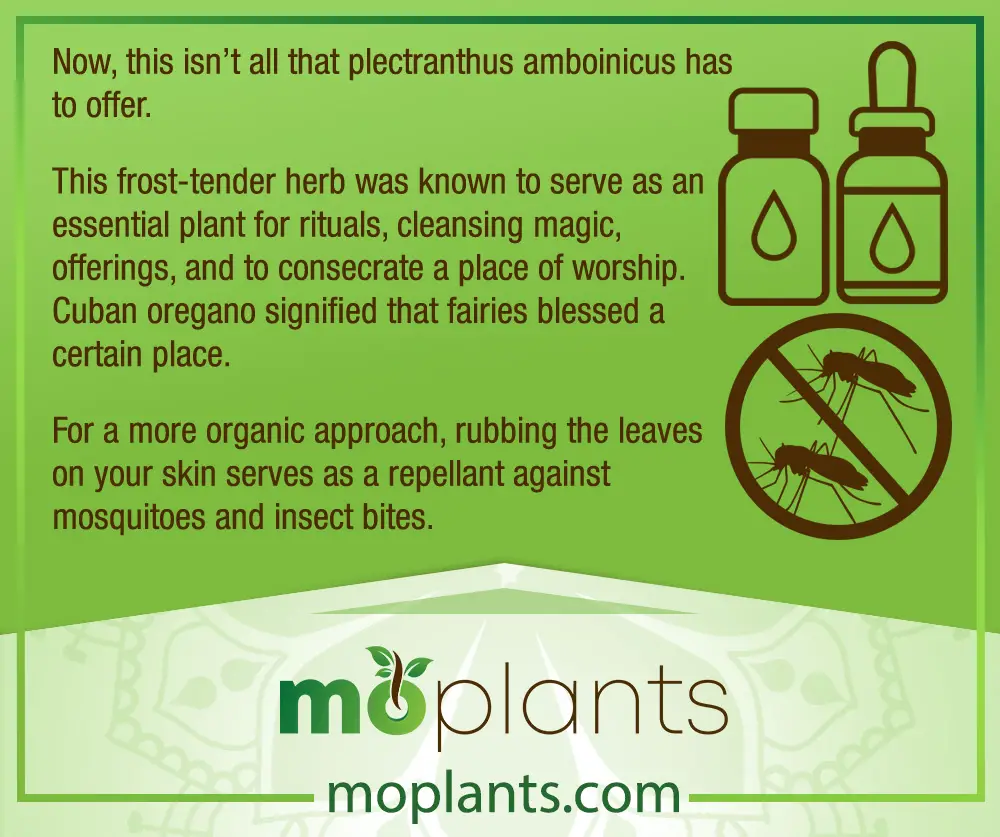
Infographic
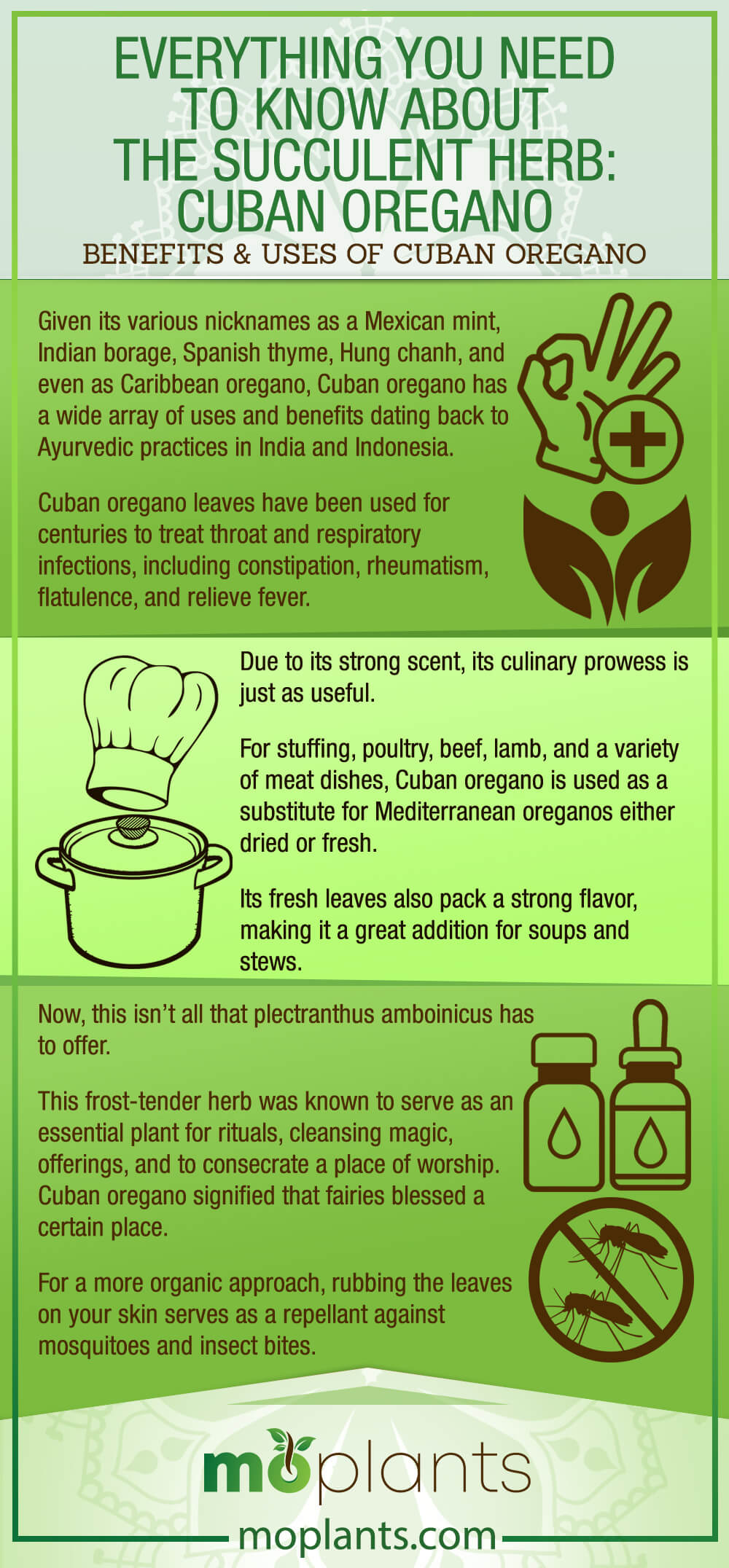
Cuban Oregano: How to Grow Must-Knows
These plants grow best with gritty, well-drained soil in tropical to semi-tropical regions. Take note, these plants don’t thrive well in frosty conditions or during winter.
That being said, it’s best to plant them indoors. Another essential growing condition of these plants is they cannot survive with consistently wet roots, meaning proper drainage is vital to their growth.
Personally, growing Cuban oreganos work well in areas with partial shade, such as porches, courtyards, and even patios that receive a few hours of sunlight throughout the day.
If you plan to grow these herbs alongside another plant, take note of plant compatibility. Other part shade plants to grow alongside Cuban oreganos include:
- Impatiens
- Coleus
- Begonia
- Fuchsia
Take Note, Gardeners!
- Make sure to protect this plant when temperatures drop below 32 degrees Fahrenheit
- If you plan to grow this plant outdoors, use a bedsheet or plastic sheet to protect them during the cold season
- The best location when growing indoors would be by the window where it can receive light from time to time
- Since it has a trailing habit, trim at least one-third of the foliage once it outgrows the container. Alternatively, you can re-pot it into a large container.
- Water it once a week and apply all-purpose fertilizer at least once a month.
Final Words
Did you know Cuban Oregano also contains Vitamin A, C, and omega 6? It’s no wonder its medicinal properties have been used even centuries ago.
It can even neutralize the heat in hot peppers!
We hope this article was able to help you understand more about Cuban oregano and its wide range of uses.
Ready to try it out for your next dish? Try adding some of its leaves to your braised beef recipe and let us know how it goes!

